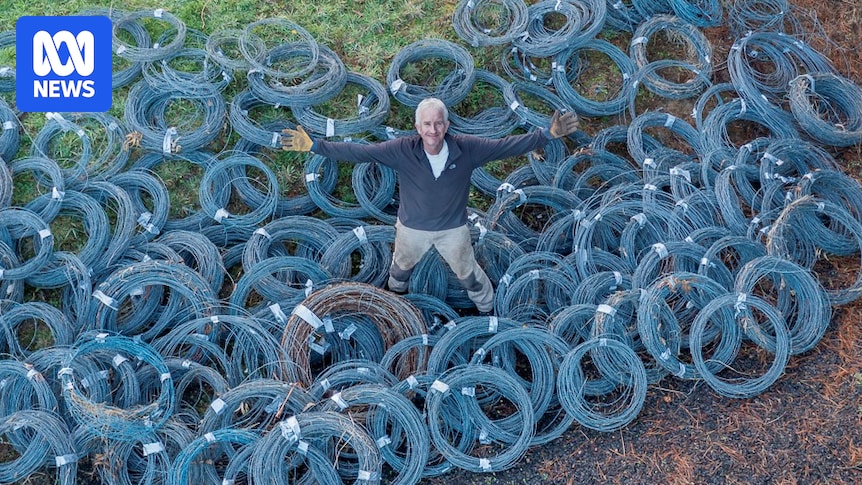When conservation photographer Doug Gimesy moved to his property in the Otways in south-west Victoria last year, he saw something distressing — an eastern grey kangaroo tangled in a stretch of barbed wire fencing.
For months afterwards, Mr Gimesy woke at 5:30am each day, spending hours cutting down and rolling up barbed wire by hand.
So far, he has removed more than 18 kilometres of barbed wire and 4km of electric fencing from around his Wongarra property.
Doug Gimesy has removed more than 18 kilometres of barbed wire from his property. (Supplied: Doug Gimesy)
Now, he is convincing his neighbours to do the same in the hopes of creating a wildlife haven.
“We just want to make sure that it’s the best possible place for animals to live and also to travel,” Mr Gimesy said.
“I mentioned to the neighbours what I was doing and the difficulty of animals passing from their property to our property.
“I asked if I could take down the fence and they said, ‘If you’re taking it down, we should really help you because we totally agree.'”
Doug Gimesy’s neighbours are also removing the barbed wire from their fencing. (Supplied: Doug Gimesy)
Common sight, serious threat
Barbed wire is a common sight across regional Australia, used to contain livestock and mark property boundaries.
But it poses a serious threat to wildlife.
Wildlife Victoria regularly receives reports of animals becoming entangled in barbed wire fences, including kangaroos, wallabies, birds, grey-headed flying foxes and sugar gliders.
In the past year alone, the organisation received 162 reports of animals trapped in barbed wire — 58 of which either died or had to be euthanased.
According to Entangled Wildlife Australia, 80 per cent of barbed wire entanglements occur on the top strand. (Supplied: Doug Gimesy)
“Barbed wire poses particular dangers for flying foxes, microbats and gliders, whose delicate wings or gliding membranes can easily become caught on the barbs,” Wildlife Victoria head of emergency response service Oscar Formoso said.
“Nocturnal species are especially vulnerable as they often do not see the wire until it is too late.”
Wildlife Victoria recommends removing barbed wire where possible, or replacing the top strand with plain or plastic-coated wire.
It also recommend identifying wildlife hotspots and covering top wires with split poly pipe, or removing barbed wire in those sections.
There are close to 1,300 barbed wire entanglements recorded in the Entangled Wildlife Australia database, with 45 different species represented. (Supplied: Doug Gimesy)
‘Changing attitudes’
Across Australia, there is a growing push to ban the use of barbed wire for property boundaries.
Entangled Wildlife Australia is collecting a database of wildlife caught in fencing to identify risk hotspots, contributing factors, and the range of species impacted — creating a dataset to support calls to ban barbed wire.
A flying fox that was rescued from a barbed wire fence. (Supplied: Jasmine Vink)
Founder Leonard Fitzpatrick hopes the project will also create an awareness around wildlife welfare.
“Changing attitudes and behaviour are key if we are to create a safer environment for our wildlife,” he said.
“Snipping the loops on face masks, disposing of hair bands, cutting the plastic rings off water and milk bottles, and adopting wildlife-friendly fencing are just some of the very simple things we can do that will make a difference.”
Back to the wild
Since removing barbed wire and making other adjustments to the fencing, Mr Gimesy said he had seen more animals move freely through his property, with a mob of kangaroos coming past his home most mornings.
He hopes to eventually return the land to bush and create a refuge for native wildlife.
“Even in those darkest times where you might think, ‘What’s the point? I’m only helping a few animals or even one animal,’ I can tell you, if you ever get the chance to look into that one animal’s eyes, it makes a big difference to them,” he said.
Doug Gimesy says each animal has a unique identity. (Supplied: Doug Gimesy)
Mr Gimesy hopes his commitment will inspire more people to think about removing their barbed wire and care for wildlife.
“The majority of animals that get caught in fencing and barb wire need to be euthanised, and, obviously, those that don’t get found, spend hours, days, in pain, eventually dying this horrible death,” he said.
“The number of animals reported caught in fencing is probably less than 1 per cent, when you think of the amount of kilometres of fencing.”

